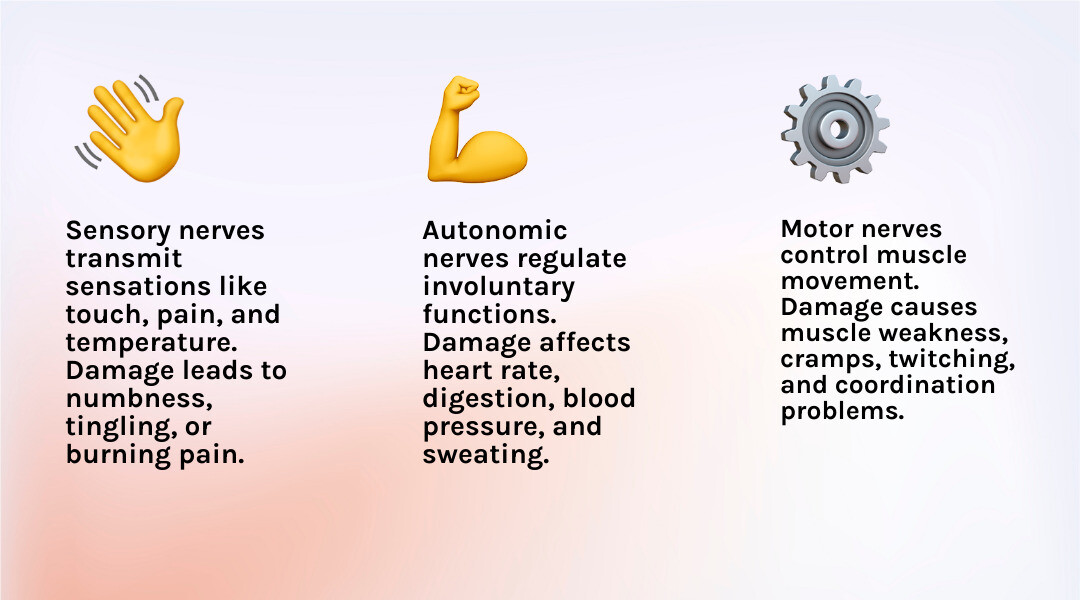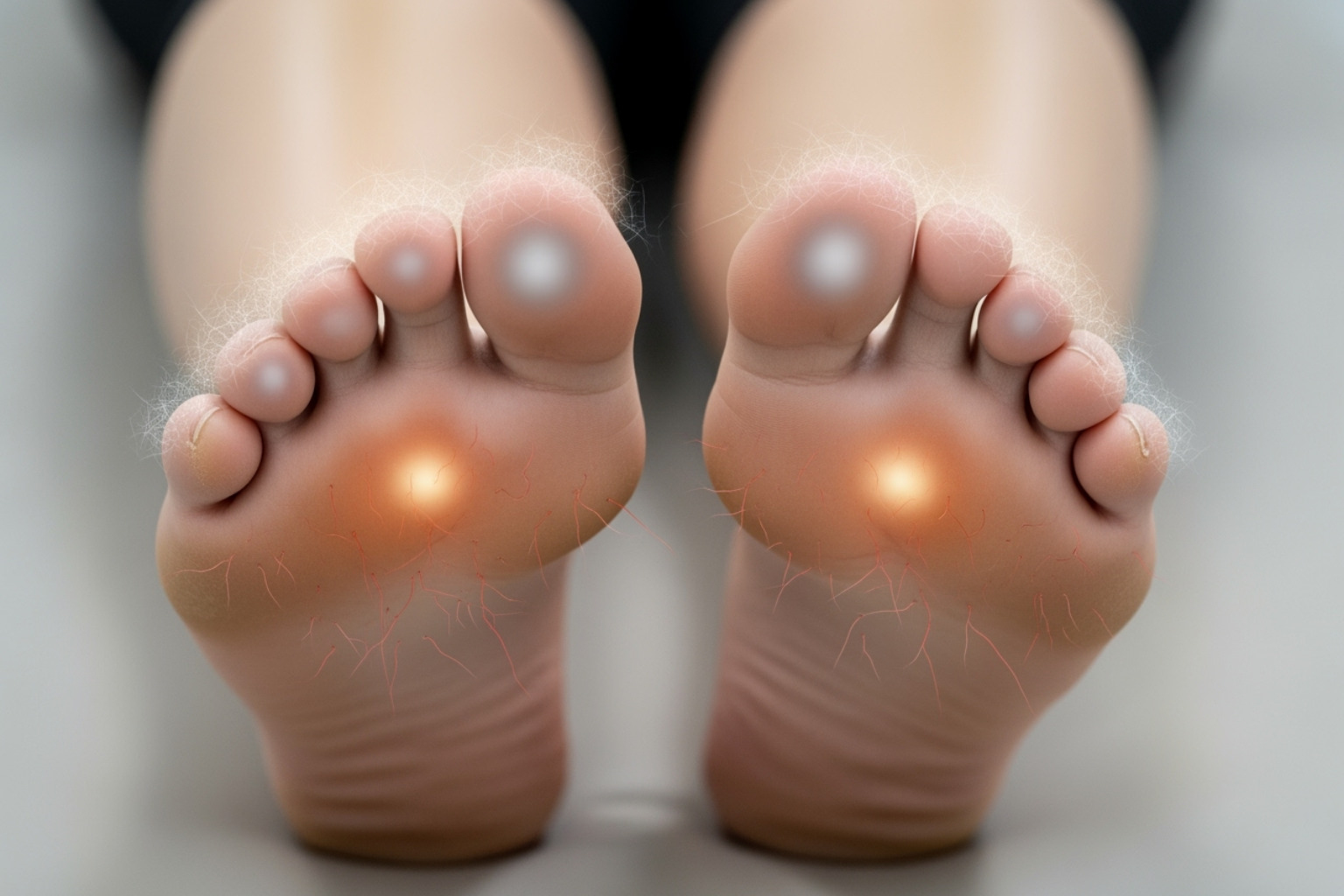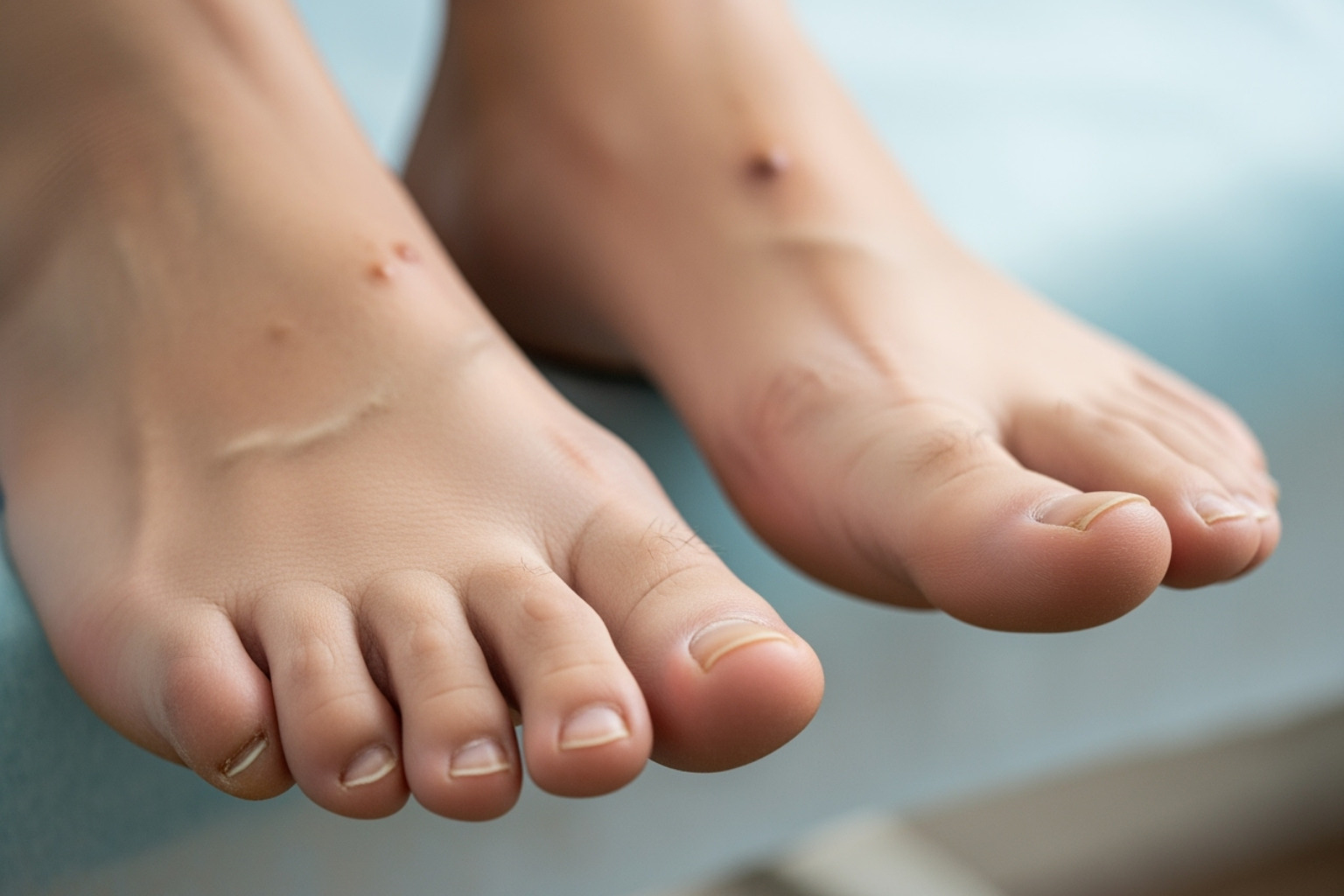Recognizing Peripheral Neuropathy Symptoms Early
That "pins and needles" feeling in your hands or feet could be a sign of peripheral neuropathy—damage to the nerves outside your brain and spinal cord. Recognizing the symptoms early is key to managing the condition and improving your quality of life.
Common signs include:
- Numbness, tingling, or prickling sensations, often starting in the feet or hands.
- Sharp, burning, throbbing, or shooting pain.
- Extreme sensitivity to even light touch.
- Muscle weakness, leading to difficulty with movement.
- Loss of balance or coordination.
- Problems with automatic bodily functions like digestion, blood pressure, or sweating.
Peripheral neuropathy is widespread, affecting an estimated 20 million people in the U.S. and about 2.4% of the global population, with rates rising to 8% for those over age 55. This guide will help you understand its diverse symptoms.
I'm Tony Enrico, and my work at Neuropasil is focused on providing advanced topical relief for conditions like peripheral neuropathy symptoms.

Peripheral neuropathy symptoms vocab to learn:
Decoding the Signals: The 3 Main Categories of Symptoms
Your peripheral nervous system has three types of nerves, and the peripheral neuropathy symptoms you experience depend on which type is damaged. Understanding this helps you and your doctor pinpoint the problem.
- Sensory nerves gather information about touch, temperature, and pain. Damage here can cause tingling, numbness, or burning sensations.
- Motor nerves control muscle movement. When they're affected, you might experience weakness or coordination issues.
- Autonomic nerves manage automatic functions like heartbeat, digestion, and blood pressure. Damage to these can lead to dizziness, digestive problems, or sweating issues.

The symptoms you experience depend entirely on which type of nerve is damaged. Someone with sensory nerve damage might feel burning or tingling, while motor nerve damage might cause weakness or difficulty walking. Autonomic nerve issues might show up as dizziness or digestive troubles.
Identifying the affected nerves is crucial for effective treatment. For more insights into managing nerve discomfort, you can explore our resources on nerve pain relief with Neuropasil.
1. Sensory Peripheral Neuropathy Symptoms: The "Pins and Needles" and Beyond
When sensory nerves are damaged, you may experience a range of peripheral neuropathy symptoms. These often begin subtly in the hands and feet.
Common sensations include:
- Numbness, tingling, or a "pins and needles" feeling. This may be constant or intermittent.
- Burning, sharp, or stabbing pain. This neuropathic pain is often worse at night, disrupting sleep.
- Extreme sensitivity to touch (allodynia). Even light pressure from clothing or bedsheets can feel painful.
- Loss of sensation. A reduced ability to feel pain or temperature changes can be dangerous, as you might not notice minor injuries like cuts or burns, especially on your feet.
- Loss of coordination and balance. When your brain doesn't receive accurate signals from your feet, it becomes difficult to maintain balance, increasing the risk of falls.
2. Motor Peripheral Neuropathy Symptoms: Weakness and Movement Issues
Damage to motor nerves affects your strength and movement. These peripheral neuropathy symptoms can start subtly but significantly impact daily activities.
Key signs include:
- Muscle weakness: Often noticed first in the hands or feet, making tasks like gripping objects or walking feel difficult.
- Difficulty with fine motor skills: Trouble with buttoning shirts, writing, or fastening jewelry is common.
- Muscle cramps and twitching: You may experience sudden, painful cramps or visible, involuntary muscle twitches (fasciculations).
- Muscle wasting (atrophy): If left unaddressed, muscles can shrink due to a lack of nerve stimulation.
- Foot drop: An inability to lift the front of your foot, causing you to drag your toes or adopt a high-stepping walk to avoid tripping.
- Balance problems: The combination of weakness and poor coordination leads to unsteadiness and a higher risk of falls.
3. Autonomic Symptoms: The Body's "Automatic" Systems Go Awry
Autonomic nerves control your body's automatic functions. When they are damaged, it can cause unsettling peripheral neuropathy symptoms that may seem unrelated to nerve issues.
Watch for:
- Blood pressure changes: Feeling dizzy or lightheaded upon standing (orthostatic hypotension) is a common sign, as nerves fail to regulate blood flow properly.
- Sweating problems: You might experience excessive sweating or an inability to sweat, which impairs your body's ability to regulate temperature.
- Digestive issues: Symptoms can include bloating, constipation, diarrhea, or feeling full after eating very little (gastroparesis).
- Bladder and sexual dysfunction: Nerve damage can lead to problems with bladder control or affect sexual function in both men and women.
These symptoms can be confusing, so it's important to discuss them with your healthcare provider.
Early & Subtle Peripheral Neuropathy Symptoms You Shouldn't Ignore
Peripheral neuropathy often begins with a gradual onset of symptoms that are easy to dismiss as normal aging or minor aches. However, these subtle signs are important warnings.
A hallmark of the condition is the "stocking-glove" pattern. Symptoms typically start in the body's longest nerves, which means you'll feel them first in your toes and feet. Over time, these sensations can spread up the legs (like pulling on stockings) and may later appear in the fingertips and hands (like putting on gloves).
You might notice persistent tingling, reduced sensation on the bottoms of your feet, or feeling unsteady in dim light. Ignoring these early peripheral neuropathy symptoms can delay diagnosis and treatment.
As the National Institute of Neurological Disorders and Stroke (NINDS) Fact Sheet notes, early recognition is key to managing the condition and improving long-term outcomes.
4. Gradual Numbness or Tingling in Hands and Feet
A classic early symptom is gradual numbness or tingling that starts in the longest nerves, affecting the toes and fingertips first. This sensation often spreads slowly upwards into the feet, legs, and hands.
Many describe it as a feeling of wearing invisible gloves or socks, which can make hands feel clumsy or reduce the sensation of the ground underfoot. This symptom is often symmetrical, appearing on both sides of the body, which helps distinguish it from a localized issue like a pinched nerve.
5. Unexplained Pain That Comes and Goes
Neuropathic pain is one of the most distressing peripheral neuropathy symptoms. It's not a typical ache but rather a sharp, shooting, or electric-shock-like pain that can occur suddenly and without a clear trigger.
This unpredictable pain may be mistaken for muscle cramps or arthritis but is a distinct sign of nerve misfiring. For those with diabetes, understanding this type of pain is especially important. You can Learn about diabetic foot pain in our detailed guides.
6. Newfound Clumsiness or Loss of Balance
If you find yourself tripping more often or feeling unsteady, it could be a peripheral neuropathy symptom. This newfound clumsiness is often caused by a combination of motor weakness and sensory loss.
Damaged motor nerves weaken your muscles, while damaged sensory nerves prevent your brain from getting accurate feedback about your body's position. This makes you feel unsteady on your feet, especially in the dark when you rely more on sensation for balance. This instability increases the risk of falls, which can lead to serious injuries.
How Neuropathy Presents: Common Types and Complications
Peripheral neuropathy isn't a single condition but an umbrella term for nerve damage that presents in many ways. It can affect a single nerve (mononeuropathy) or multiple nerves (polyneuropathy).

Globally, about 2.4% of people have some form of neuropathy, a figure that rises to 8% in those over age 55. The causes are just as varied:
- Diabetes: The leading cause, as high blood sugar damages nerves over time.
- Chemotherapy: Certain cancer treatments can be toxic to nerves.
- Vitamin Deficiencies: Lack of B vitamins (B1, B6, B12), copper, or vitamin E can impair nerve health.
- Injury or Pressure: Trauma or repetitive motions can compress and damage nerves.
- Autoimmune Diseases: Conditions like lupus or rheumatoid arthritis can cause the immune system to attack nerves.
- Idiopathic: In up to 30% of cases, the specific cause is unknown.
7. Mononeuropathy: When a Single Nerve is the Problem
Mononeuropathy is damage to a single peripheral nerve, causing peripheral neuropathy symptoms in a specific, localized area. Common examples include:
- Carpal Tunnel Syndrome: Compression of the median nerve in the wrist leads to numbness, tingling, and pain in the hand and fingers.
- Bell's Palsy: Inflammation of the facial nerve causes sudden weakness on one side of the face.
- Sciatica: Affects the sciatic nerve, causing sharp, shooting pain that runs from the lower back down the leg. You can Read more on Sciatica Symptoms to understand this condition better.
8. Polyneuropathy: Widespread Nerve Damage
Polyneuropathy, the most common pattern of peripheral neuropathy, involves widespread damage to multiple nerves, usually symmetrically on both sides of your body. Symptoms typically start in the longest nerves first (feet and hands) and progress upwards.
The leading cause is diabetic neuropathy, which affects about 60% to 70% of all people with diabetes due to nerve damage from high blood sugar. While most polyneuropathies develop slowly, some, like Guillain-Barré syndrome, are rapid and severe, with the immune system attacking the nerves and causing sudden weakness or paralysis. This highlights why recognizing any peripheral neuropathy symptoms early is so important.
9. The Impact on Muscle Function and Coordination
The peripheral neuropathy symptoms that affect motor and sensory nerves have a profound impact on physical ability. The combination of muscle weakness and sensory loss significantly contributes to falls. Sensory loss includes diminished proprioception, your body's sense of its position in space. Without it, your brain doesn't get clear signals from your feet, making every step uncertain. This combination makes daily activities like walking or writing challenging and can seriously impact your independence and quality of life.
10. Complications of Untreated Neuropathy
Ignoring peripheral neuropathy symptoms can lead to serious complications. It's crucial to address them early to prevent:
- Foot ulcers and infections: A lack of sensation means minor cuts or blisters on the feet can go unnoticed, leading to severe infections.
- Risk of amputation: Untreated infections, particularly in people with diabetes, are a leading cause of lower limb amputations.
- Chronic pain: Persistent nerve pain can severely impact sleep, mental health, and overall quality of life.
- Permanent nerve damage: Without treatment, nerve damage can become irreversible, resulting in a permanent loss of function.
Early diagnosis and management are essential. For more information, the Mayo Clinic offers an authoritative overview.
Frequently Asked Questions about Peripheral Neuropathy Symptoms
Can peripheral neuropathy be reversed?
Reversibility depends on the cause and extent of the damage. If an underlying cause like a vitamin deficiency or diabetes is treated early, nerve function can improve, and symptoms may ease or even disappear. However, if the damage is severe or long-standing, it may be permanent. In these cases, treatment focuses on managing symptoms and preventing further progression.
Is fatigue a symptom of peripheral neuropathy?
While fatigue is common, it's not a direct symptom of nerve damage. It's usually a secondary effect of living with the condition, resulting from factors like chronic pain, poor sleep, the physical effort of moving with muscle weakness, or the underlying medical issue causing the neuropathy.
When should I see a doctor for these symptoms?
You should seek medical care for any persistent or unusual tingling, weakness, or pain in your hands or feet. It's easy to dismiss gradual symptoms, but early diagnosis significantly improves outcomes. A doctor can identify the cause and recommend a management plan to prevent further damage and provide relief from your peripheral neuropathy symptoms.
Conclusion: Taking Control of Your Nerve Health
Recognizing peripheral neuropathy symptoms is the first step toward taking control of your nerve health. From sensory changes to motor and autonomic issues, the signs can be diverse. Early detection and a professional medical diagnosis are critical for effective management. By working with your doctor, you can identify the underlying cause and develop a strategy that may include medical treatments and lifestyle changes like a balanced diet and gentle exercise.
Living with nerve pain is challenging, but you don't have to do it alone. For soothing comfort, topical options like Neuropasil can be a helpful part of your management plan. Our creams, made with natural ingredients, are designed to provide targeted relief from burning, tingling, and aching. While not a cure, a topical cream can help you live more comfortably.
Take proactive steps to manage your nerve health. For more information, explore our Nerve Pain resource page.
References/Sources
Understanding peripheral neuropathy is an ongoing journey, and we've drawn from some of the most trusted medical institutions and research organizations to bring you accurate, reliable information. If you'd like to dive deeper into any of the topics we've covered, these sources offer comprehensive insights into nerve health, symptoms, causes, and treatment options.
Houston Methodist provides an excellent overview of early warning signs that shouldn't be ignored. Their article, What Are the Early Warning Signs of Neuropathy?, offers practical guidance on recognizing subtle symptoms before they progress.
The Mayo Clinic is a gold standard for medical information, and their comprehensive page on Peripheral neuropathy - Symptoms and causes covers everything from risk factors to potential complications in detail.
For our friends across the pond, the NHS offers clear, accessible information about Peripheral neuropathy - Symptoms, helping you understand what to watch for and when to seek medical attention.
Cleveland Clinic provides an excellent resource covering the full spectrum of peripheral neuropathy, including detailed treatment approaches. Their guide on Peripheral Neuropathy: What It Is, Symptoms & Treatment is thorough yet easy to understand.
The National Institute of Neurological Disorders and Stroke (NINDS), part of the National Institutes of Health, offers authoritative research-backed information. Their Peripheral Neuropathy Fact Sheet is an invaluable resource for understanding the science behind nerve damage.
Finally, NeuropathyLab provides patient-focused information about recognizing symptoms early. Their article on Peripheral Neuropathy Symptoms: Recognizing the Signs Early complements our discussion with additional perspectives on symptom identification.
These sources represent the foundation of credible, evidence-based information about peripheral neuropathy. We encourage you to explore them alongside our resources here at Neuropasil as you take charge of your nerve health journey.













